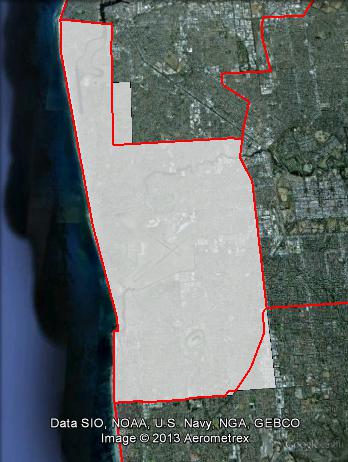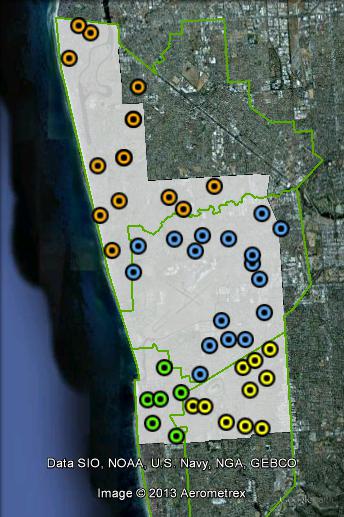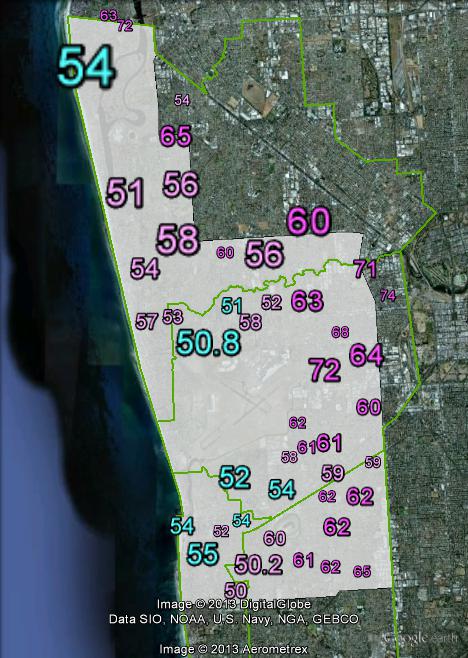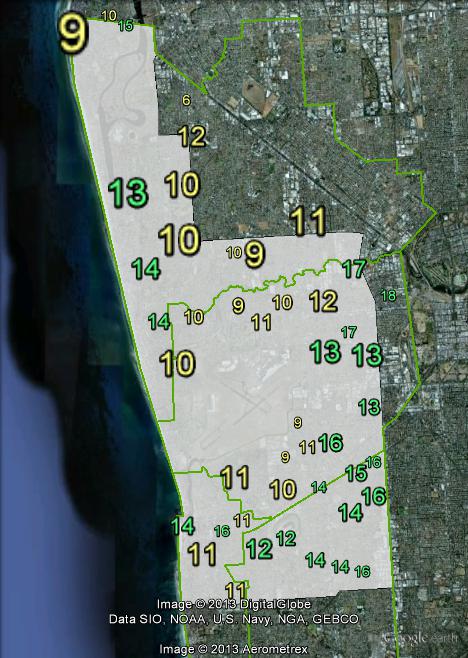ALP 6.1%
Incumbent MP
Steve Georganas, since 2004.

Geography
Western Adelaide. Hindmarsh covers suburbs along the coast to the west of the Adelaide CBD. The seat covers parts of Charles Sturt, Holdfast Bay, Marion and West Torrens council areas.
Redistribution
Hindmarsh covers all of the territory from the 2010 version of the seat, along with parts of Seaton transferred from Port Adelaide and parts near Ascot Park from Boothby. This increased the ALP’s margin from 5.7% to 6.1%.
History
Hindmarsh is an original South Australian seat, having been created for the 1903 election. In that time, only once has the Labor Party lost the seat to an opposing politician.
The seat was first held by James Hutchison of the ALP, who held the seat from 1903 to his death in 1909, and he was succeeded by William Archibald at the 1910 election. Archibald served in Andrew Fisher’s third government as Minister for Home Affairs. Archibald followed Prime Minister Billy Hughes out of the ALP in 1916 over conscription, and briefly served as a minister in Hughes’ National Labor minority government before he returned to the backbenches in the new Nationalist government. Archibald was reelected in 1917 before being defeated in 1919.
After Labor won the seat back in 1919, they held it for the next 74 years continuously. The seat was won in 1919 by Norman Makin, who went on to serve as Speaker during the Scullin government and as a minister under Curtin and Chifley, before leaving Parliament in 1946 to serve as Ambassador to the United States.
Albert Thompson won the seat in 1946, and held it for one term before moving to the new seat of Port Adelaide. Hindmarsh was won in 1949 by Clyde Cameron, who was a major figure in the ALP during the long years of opposition of the 1950s and 1960s, serving as Deputy Leader and a leading figure in the Left of the party. He served in the Whitlam ministry from 1972 to 1975 and continued as an opposition backbencher until his retirement in 1980.
The seat was held by John Scott from 1980 until his retirement in 1993. The 1993 election saw the neighbouring marginal Liberal seat of Hawker abolished, and sitting Member for Hawker Christine Gallus won Hindmarsh off the ALP. This was the only time the ALP had lost the seat to another party in ninety years.
Gallus served as a Shadow Minister in the last term of the Keating government and served in the Howard government as a Parliamentary Secretary in the early 2000s before retiring in 2004. In the election to succeed her, Steve Georganas of the ALP defeated Simon Birmingham by only 108 votes.
A swing of 5% to the ALP saw Georganas comfortably re-elected in 2007. In 2010, he gained a further swing of 0.65%.
Candidates
- Andrew Payne (Greens)
- Matt Williams (Liberal)
- George Peter Melissourgos (Palmer United Party)
- David McCabe (Democratic Labour Party)
- Kym McKay (Katter’s Australian Party)
- Steve Georganas (Labor)
- Robert Randall (Family First)
Assessment
Hindmarsh has a Labor margin of 6.1%. In current circumstances, that margin is certainly not safe, but the swing could well be less severe in South Australia, and Georganas has consistently increased the Labor vote at the last three elections.
2010 result
| Candidate | Party | Votes | % | Swing |
| Steve Georganas | ALP | 39,736 | 44.54 | -2.67 |
| Jassmine Wood | LIB | 34,831 | 39.04 | -1.04 |
| Matthew Fisher | GRN | 10,773 | 12.07 | +5.09 |
| Bob Randall | FF | 2,563 | 2.87 | +0.75 |
| Greg Croke | DEM | 767 | 0.86 | -1.14 |
| Adrian Paech | CLSK | 554 | 0.62 | +0.62 |
2010 two-candidate-preferred result
| Candidate | Party | Votes | % | Swing |
| Steve Georganas | ALP | 49,698 | 55.70 | +0.65 |
| Jassmine Wood | LIB | 39,526 | 44.30 | -0.65 |

Booth breakdown
Booths have been divided into four areas. Hindmarsh covers parts of four local government areas: Charles Sturt, West Torrens, Marion and Holdfast Bay. The first two each make up approximately one third of the electorate, with the rest lying in the two southern councils. Holdfast Bay polling places mostly match the suburb of Glenelg.
The ALP won a majority in three areas, with 56.2% in the northern Charles Sturt area, and around 59% in Marion in West Torrens.
Holdfast Bay or Glenelg bucked the trend, with 52.7% voting for or preferencing the Liberal Party.
The Greens vote varied from 10.9% in Charles Sturt to 14.1% in Marion.
| Voter group | GRN % | ALP 2CP % | Total votes | % of ordinary votes |
| Charles Sturt | 10.85 | 56.21 | 25,322 | 35.02 |
| West Torrens | 11.97 | 59.13 | 25,062 | 34.66 |
| Marion | 14.12 | 59.50 | 12,781 | 17.67 |
| Holdfast Bay | 11.76 | 47.33 | 9,150 | 12.65 |
| Other votes | 12.80 | 53.79 | 20,003 |




More inner-city electorate that I would say is less likely than the outer Adelaide seats to swing wildly. Bookies have the Libs as solid ($1.40/$2.75) favourites, which I think offers a bit of value for Georganas.
Hi. I’m a great admirer of the site, if someone with quite opposed politics – I think your analyses are generally robust and sensible. But in this case, I think you’ve missed soething.
As the numerical pictogram suggests, in this case I think you’ve drawn the booth clusters in a way that isn’t consistent with the electoral patterns. In broad terms, there is a West-East trend with labour vote – the Liberals get a ribbon of shore-front booths, which falls off about 250 metres away from the coast, with an inland “bulge” around Glenelg – an area traditionally regarded as “Burnside by the Sea” – popular with retired farmers and in particular their widows – with a strong local Liberal presence at state level (the Liberals have held the state seat covering Glenelg at all but about 3 state elections since two party government developed in SA). The north eastern parts of the seat – the part closest to the suburb and former municipality from which the seat takes it name – is the old Hindmarsh Labour heartland, while the coast and south west has always been much more marginal and/or Liberal – this is the area absorbed from Hawker, historically a somewhat Labour-leaning marginal.
Thanks for that, unfortunately I don’t have enough knowledge about every seat in the country to know how best to split a seat up, so I usually rely on local government boundaries. Do you think it would be more useful if I broke up Marion and Holdfast Bay as two separate areas? Now that I look more at the map I can see that the south-western corner of the seat would have a Liberal-voting majority.
Ben, is there an email address I can send you a pdf on?
ben(at)tallyroom.com.au – it’s on this page: https://www.tallyroom.com.au/about
Rather than .pdf – this might help
The seat can be thought of as roughly 4 quadrants, with Adelaide Airport and a few golf courses in the middle, with no voters.
Starting on the coast, from the Patawalonga north, in the North west, there is a fringe of Lib or marginal booths along the coast, interrupted only by a caravan park with permanent residents at West Beach.
Inland a few hundred metres begin the north western indutrial suburban arc – these are remnants of traditional left wing Hindmarsh, which has largely been absorbed into Port Adelaide (as has the suburb of that name). I’d run that zone down to Richmond Road – which is a continuation of Greenhill Road, the southern boundary of the city of Adelaide (see the edge of the parklands in the right of the picture). There is a bit of a lib bulge up through the more modern Torrens Valley infil suburbs around Fulham.
Then there is a south eastern zone – still fairly solid for Labour, but less so than the north west. Some of this area has been volatile – it was the heavily fought over parts of Hawker. If you go back I think you’ll see Gallus scraping narrow majorities in most of those often small booths.
In the south west is Glenelg, running from the Patawalonga to roughly Brighton Road – a traditionally strongly conservative area – popular with retirees, and with some modern resort development. Glenelg penetrates further inland than does the northern coastal strip partly reflecting settlement patterns: Glenelg is an historic seaside resort, and was built up well before WWII, whereas much of the rest of the seat, especially in a band passing from the NW corner to the SE corner, is post War.
Under the “Playmander”, the seat of Glenelg – which covered much of the southern half of the electorate – was the seat that fell (in 1962) to push Playford into minority government. When boundaries were re-drawn on something like an equal voting weight, there was one safe Liberal seat – Morphett (won once by Labour in a good result in 1977, and typically with a 10+% margin) and one marginal Liberal seat with very fluid boundaries variously called Hanson or Peake held for about 25 years by Heini Becker.
Linton Mudie is the Palmer United Party candidate
http://palmerunited.com/2013/07/clive-palmer-announces-sa-candidates-for-palmer-united-party/
Polling shows this is as line ball as it gets.
What’s the liberal candidate’s background
I’ve deleted a bunch of comments here to end the flame-war.
Probably a few more comments on a few more seats you could safely bin as well, Ben……..
Liberal candidate’s background is as a lawyer for the past 10 years.
Palmer United Party’s Candidate is now myself.
Apparently a Galaxy poll shows Labor “in trouble” in this seat.
A teaser for SkyNews to reveal it, it seems….
I’d expect about a 55/45 MDM.
Galaxy poll has it 50/50
If it stays around 50-50 it might come down to the Greens holding around 10% and a little donkey vote?
Adelaide’s Sunday Mail brought us a Galaxy poll of 586 respondents in Hindmarsh, Labor’s most marginal seat in South Australia, which had the result at 50-50, a swing to the Liberals of 6%.
I am surprised. Internal polling has Labor well behind, but perhaps this is correct off a larger sample.
On the donkey vote. if the top candidate gets the donkey vote doesn’t it stand to reason that the donkey vote goes down the ballot order aka the second candidate gets the 2, the third candidate gets the 3?
If that is the case doesn’t the Liberal actually benefit?
Having reviewed that Galaxy poll more closely, I believe Labor should have been ahead in this based on preference distributions from 2010. This poll could be an indication that it may stay the status quo in SA.
I am reliably informed that there will be a swing in Boothby to the Liberals and polling is no longer being conducted in that seat.
The Libs are still pressing hard in Wakefield, Adelaide and Makin.
@ DB – I was in Adelaide on the weekend and, although the visit was short, was very surprised at the very low level of evident Liberal campaigning – Liberal postering in the parts of Boothby, Hindmarsh and Adelaide I visited was well below Labor, Xenophon and (even) Palmer United.
As a Lib and a former SA campaigner I was disappointed – only a few cycles ago the Libs had good on the ground campaign resources who could compete well with any of their challengers. It wasn’t obvious that any big swing was in place either. Only in Sturt did the campaign look up to par.
@Pyrmonter – great to hear that you were around and (even) notice the PUP signage (as I have put most of them up myself).
The Liberal candidate has blue corflutes (signage) which are easily mistaken for the Labor incumbents, but there are many times more of both parties than what our funding could allow.
I don’t know if your info is reliable in SA DB. I think the polling you see is too small of sample and while it has been somewhat accurate in NSW, I don’t think internal polling can accurately predict SA seats and even though I don’t think labor will gain boothby, anything is possible in marginal marginal seats
And unfortunately your sources are wrong in regards to boothby polling being conducted still
Observer – polling may be being done by Labor in Boothby.
Internal polling now putting Labor just ahead.
Internal polling puts Labor ahead in this seat now.